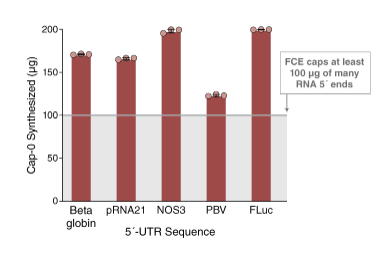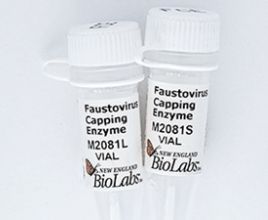![[NEB] Faustovirus Capping Enzyme (FCE)](https://www.korambiotech.com/wp-content/uploads/2022/09/220923-faustovirus-capping-enzyme-fce.jpg)
Faustovirus Capping Enzyme (FCE)은 전사체 (riphosphorylated and diphosphorylated RNA)의 5’말단에 m7G (N7-methylguanosine cap)을 추가하여 Cap-0 RNA 생산을 촉매 하는 효소입니다.
FCE은 Vaccinia Capping Enzyme (VCE) (#M2080S)과 비교하여 적은 양으로도 증가된 Capping 효율을 보여줍니다. 낮은 Capping 효율을 고민하는 연구자분들께 대안으로 권장합니다.
- Faustovirus Capping Enzyme adds the m7G-cap (Cap-0) to the 5′ end of triphosphorylated and diphosphorylated RNA.
- Experience improved capping efficiency, even on difficult substrates
- Achieve robust capping with less enzyme
- Set up reactions under a broad temperature range, for added flexibility
- Choose as an alternative to Vaccinia Capping System, with minimal optimization required
- Enable one-pot Cap-1 synthesis, as FCE is compatible with mRNA Cap 2′-O-Methyltransferase
- Benefit from no licensing fees from NEB for the use of FCE (licensing 비용 없음)
- GMP-grade 출시 예정 (현재 Vaccinia Capping Enzyme은 GMP-grade로 구입 가능)
| NEB # | Component Name | Amount | Concentration |
| M0281S | Faustovirus Capping Enzyme | 1 x 0.02 ml | 25,000 units/ml |
| FCE Capping Buffer | 1 x 0.5 ml | 10 X | |
| S-adenosylmethionine (SAM) | 1 x 0.1 ml | 32 mM | |
| GTP | 1 x 0.05 ml | 10 mM |
Cap-0, commonly referred to as m7G cap or m7GpppN (where N signifies any ribonucleotide), is a N7-methyl guanosine connected by a 5′ to 5′ triphosphate linkage to the 5′ end of a transcript. Cap-dependent translation initiation, which is the primary mechanism of translation initiation in eukaryotes, requires cap 0 structure. 2′-O-methylation at the first position following the Cap-0 nucleotide generates Cap-1, which can also be represented by m7GpppNm-. Cap-1 has been shown to prevent inappropriate activation of antiviral innate immune receptors by endogenous transcripts in vivo.
FCE maintains near-optimal capping activity up to 50°C. Capping activity is reduced at temperatures below 37°C, though more activity is seen with FCE than with VCE at the same molar concentrations.
Figure 1. FCE offers increased capping efficiency and workflow optimization

A. mRNA capping by FCE and Vaccinia Capping Enzyme (VCE) at 37°C. 200 μg (~350 picomoles, 7 μM) of a 1.77 kb FLuc transcript having 5´-UTR sequences as indicated were treated with a limiting amount of FCE (25 units, 1 picomole, 20 nM in 50 μl) or VCE (10 units, 1 picomole, 20 nM in 50 μl) for 1 hour at 37°C. Note that this is less than our recommended amount of enzyme highlighting the increased capping efficiency of FCE vs VCE and the potential benefits of workflow optimization.
B. mRNA capping by FCE at 37°C and 42°C. 200 μg (~350 picomoles, 7 μM) of a 1.77 kb FLuc transcript having 5′-UTR sequences as indicated were treated with a limiting amount (25 units, 1 picomole or 20 nM) of FCE for 1 hour at 37°C or 42°C. Note that this is less than our recommended amount of enzyme highlighting the potential benefits of workflow optimization. All capping reactions were performed in 50 μl reactions containing 0.1 mM SAM, and 0.5 mM GTP, 1X FCE Capping Buffer for FCE reactions or 1X Capping Buffer for VCE reactions. Following capping reactions, mRNA capping was measured using targeted RNase H cleavage and LC-MS.
Figure 2. FCE expands temperature range for RNA capping reactions

RNA capping by FCE and VCE from 15ºC to 60ºC. Capping reactions (20 μl) contained 2.5 μM RNA substrate (5´-triphosphate 20mer 3´-FAM), a limiting concentration (8 nM) of capping enzyme, 0.1 mM SAM, and 0.5 mM GTP. FCE capping reactions were performed in 1X FCE Capping Buffer, and VCE capping reactions were performed in 1X Capping Buffer. All reactions were incubated for 30 minutes at the indicated reaction temperature. Reaction products were measured by capillary electrophoresis.
Figure 3. FCE offers robust capping of a variety of RNA 5´ ends (at least 100 μg yield per 50 units)

Extent of mRNA capping by FCE. 200 μg (~350 picomoles, 3.5 uM) of a 1.77 kb FLuc transcript having 5´-UTR sequences as indicated were treated with 2 μl (50 units, 2 picomoles, 20 nM) of FCE in 100 μl reactions containing 1X FCE buffer for 1 hour at 37°C. Following capping reactions, mRNA capping was measured using targeted RNase H cleavage and LC-MS.


